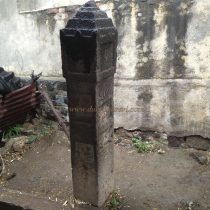KARWAND
TYPE : FORTRESS
DISTRICT : DHULE
GRADE : EASY
Khandesh province is also known as vatan of “Saade Bara Rawals”. Rawal is the title and there are different clans like Sisodia, Solanki, Parmar, and Pratihar. These “Saade Bara Vatan” are 1. Dondaicha 2. Malpur 3. Sindkheda 4. Ashte 5. Sarangkheda 6. Ranjane 7. Lambola 8. Lamkani 9. Chaugaon 10. Hatmoida 11. Ranale 12. Manjare 13. Karvand is half in Khandesh and half outside Khandesh, hence “Saade Bara”. Out of these, 4 fortress namely Ashte, Lambola, Chaugaon, Hatmoida have been completely destroyed and 4 fortress still remain in their original form, while the remaining 5 fortress are struggling with time while maintaining their remnants. As villages are located in most of these fortress, the increasing population in the villages has encroached on the remnants of these fortress and the apathy of the locals is also contributing to the decline of these fortress.
...
Most of the forts are falling into disrepair as it becomes difficult for the owner of the fortress to maintain it which is a private property. Karvand fort on the banks of Uranavati River is one of them. In today's computer age, information about this fortress is not visible even on the internet. I have tried to present the information obtained on this website when our Durgbharari group made a study tour of all these fortress. Karvand fortress is 60 km from Dhule city and can be reached via Shirpur. Shirpur-Karvand distance is only 5 km. On entering the village, a small road turns uphill on the left. Right in front of here are the remaining ruins of Karvand Fort. There is a newly built cement concrete building on the original structure of the fortress and below this building the stone foundation of a bastion of the fortress and a brick building can be seen on it. At this place, the remains of the ramparts and the old wada (mansion) can still be seen to some extent. Beyond the house on the left side of the ramparts there is a small cowshed and in this cowshed one can see a six-foot high memorial (virgal). This memorial is carved on all four sides and is divided into two types: Satishila and Virgal (memorial). On one side, the hand of Sati is engraved and on the other side, the obituary of a warrior is engraved. This memorial must be from the Rawal family. On the upper side of cowshed, there is a building newly constructed by the descendants of Rawal. A medium sized cannon can be seen on the way to this building. According to the description of the fortress made by the descendants of Rawal, this fortress had a total of nine bastions and it was spread over an area of about one acre. At present, as there are other houses in this fortress apart from Rawals house and the remaining remnants of the fortress have been destroyed by this settlement, it is not possible to estimate the size of the fort and other remains. Half an hour is enough to see the ruins of the fortress, the cannon and other things. Apart from this, there is a must-see well with steps to descend into it, from the Holkar period outside Karvand village. This well is 60 feet long and equally deep. There are steps to descend into this well and many arches are built on these steps. Karvand fort is not very distinctly referred to in history. After Khilji invasion, 24 clans of Rajput headed towards Mandu under the leadership of Abhay Singh Rawal. Among these 24 clans, one clan belonged to the Parmar’s. This Parmar clan established the Karvand Sansthan. Even though there was a change of power from time to time, that ruler did not make any changes in the authority of Rawal.
© Suresh Nimbalkar








